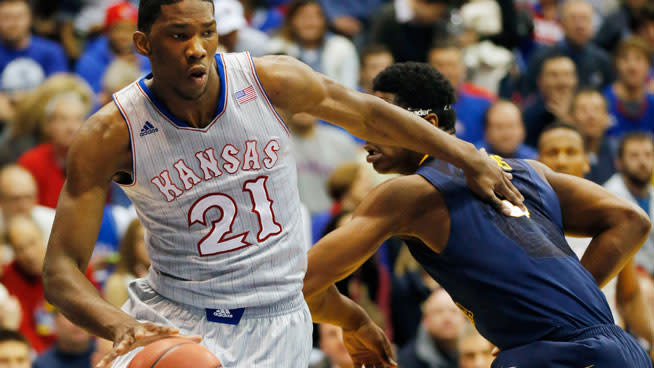Joel Embiid's Back Injury Should Not Keep Him From Going No. 1 in the NBA Draft

Kansas Jayhawks center Joel Embiid has the size, talent and upside to be the No. 1 overall pick by the Cleveland Cavaliers in next week’s NBA Draft. He has looked great in workouts, moving extremely well for a 7-footer.
Still, some draft analysts are concerned about Embiid’s ability to perform in the NBA due to a recent back injury. In February, Embiid suffered a lumbar stress fracture known as spondylolysis. Although recent reports say his back is doing great, worries persist about drafting a center with injury concerns No. 1 overall.
Since Tim Duncan was chosen first overall in 1997, the following centers have been selected with the first overall pick: Michael Olowokandi, Kwame Brown, Yao Ming, Dwight Howard, Andrew Bogut, Andrea Bargnani, Greg Oden and Anthony Davis. All of these players have suffered injuries, including hernias, knee surgeries, back surgeries, chronic foot pain and foot surgeries. Although some of them have been productive despite their injuries, a center chosen with the top pick has been a 50/50 proposition at best in recent years.
RELATED: How You Can Jump as High as Andrew Wiggins
Can Embiid be productive in the NBA? How serious is his injury?
On Philly.com, Dr. Robert Senior wrote, "Spondylolysis is the most common lower-back injury associated with overuse in sports and is especially common in growing adolescents and teens. While Embiid recently turned 20, his tremendous height and status as a relative newcomer to the sport of basketball (he first played competitively in 2011) would suggest a higher risk for such an injury."
Embiid is not the first big man to suffer a lumbar stress fracture. While he was in college, Emeka Okafor missed two Big East tournament games with a lower-back stress fracture before leading UConn to a national championship. Okofar then saw specialist Dr. Andrew Dossett and, according to a March 2004 ESPN story, "Dr. Dossett told Emeka that he finds this problem in hundreds of elite athletes, and they're still playing. What happens is the stress fracture is on a tiny little part of the bone, and then the extra motion triggers muscle around it to go into pain and then a spasm, and that's when you see Emeka's face wince. He told him it's not a long-term problem."
Selected second in the 2004 Draft behind Dwight Howard, Okofar has averaged 12.3 points and 9.9 rebounds in nine NBA seasons.
When basketball players get diagnosed with spondylolysis, they must rest until they recover fully. If they resume activity too soon, they risk developing spondylolisthesis, which is a worsening of the fracture to the point that one vertebra slips forward, creating a gradual worsening of leg pain, weakness, neurological changes and the possibility of career-ending surgery.
RELATED: Athlete's Guide to Back Injury Rehabilitation
Between his injury in early February and the NBA Draft in late June, Embiid has been fortunate to have enough time to heal, restore strength and gain weight. If he has healed completely, the long-term effects of his injury should be non-existent. Re-injury is extremely uncommon when an athlete has no underlying cause for bone loss or fracture.
Embiid has only been playing basketball competitively for three years. He has demonstrated an ability to quickly pick up the game and dominate both ends of the floor. Even with this injury, it would appear that his best years are ahead of him.
This article originally appeared on STACK.com: Joel Embiid's Back Injury Should Not Keep Him From Going No. 1 in the NBA Draft

